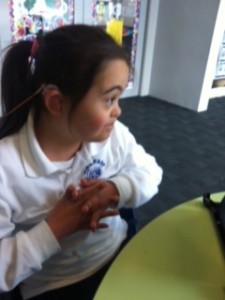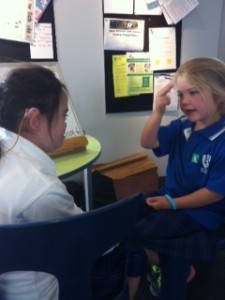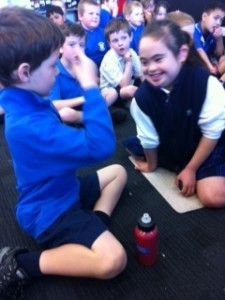Grita is a 10 year old girl who is deafblind, has Down Syndrome and developmental delay. She is blind in her left eye and has 4/60 vision in her right eye.
Grita is in a mainstream setting and is attending her local primary school.
Here BLENNZ Resource Teacher: Vision Lynlee Pendrigh who is her weekly ORS teacher, talks about how Grita uses key New Zealand Sign Language signs and speech to communicate alongside her peers in the classroom.
In figure 1 Grita is signing the letter W.
Signed alphabet
Grita is learning the letters of the alphabet using the two-handed New Zealand signed alphabet. She is also practising receiving signed letters.
Grita practises with individual classmates and in a group. In figure 2 Grita is practising with her classmate Macy to sign her name.
Prerequisite skills
- Grita had had some learning experiences with the written and spoken alphabet.
- Grita’s classmates, teacher and teacher-aide also learned the signs for the letters of the alphabet, so that it was an inclusive programme.
- Grita and her classmates practised making the signs precise, within a small frame and not too fast, because the viewer needs clear signs for receptive understanding.
- Her parents and sister also learned and practised the signed alphabet to reinforce Grita’s learning at home.
In figure 3 Grita is practising her sign language with a small group.
Possible next steps
- Expressive and receptive fingerspelling of her classmates’ names’ using the first and last letters.
- Fingerspelling and receiving interest words and basic word lists from flash cards.
- Receiving fingerspelled letters to type on the Bluetooth keyboard with her iPad.
Teaching methods and strategies
- Grita and her classmates practised the alphabet as a class group.
- Grita and her classmates practised receiving the signs from another person.
- The children practised the signed alphabet in groups of four students. Grita was very motivated by seeing her peers use the letter signs.
- We separated the vowels from the consonants. The vowels were practised on each finger of one hand.
- The children drew around their hand shapes and wrote each vowel next to the appropriate finger.
- Teachers used visual modeling of the alphabet within 30 cms.
- We also used hand over hand and hand under hand for correct placement of fingers.
- Due to Grita’s fine hand movement difficulties, according to the Down Syndrome phenotype, we allowed for variations for some letters, eg. Instead of little fingers entwined for ‘s’, Grita used entwined thumbs and 4 fingers, instead of 3, on the palm for ‘m’.
Learning adaptations
- Practice of the letters was done in pairs or small groups so that Grita was able to follow the actions of a few children, rather than coping with a larger group.
- Her classmates had to make sure that their signs were expressed in a small square, rather than in gross movements that Grita would miss.
- Grita’s iPad was an ideal tool for videoing the practice in groups and pairs. Grita was able to replay the action, so that she could keep reviewing herself and her classmates signs.
- Due to Grita’s fine hand movement difficulties, according to the Down Syndrome phenotype, we allowed for variations for some letters, eg. Instead of little fingers entwined for ‘s’, Grita used entwined thumbs and 4 fingers, instead of 3, on the palm for ‘m’.
- We use a YouTube clip of other school children signing individual letters and saying them at the same time and a clip of hands signing letters in a close up shot along with the typed letter.
Assessment
Children with Down Syndrome learn best in active learning situations and with repetitive visual information. Children learn from other children, even within mixed knowledge levels .Vygotsky states that children can have joint focus of attention, share perspectives and achieve levels that they can’t on their own (Zone of Proximal Development). Deaf children perceive both language and non-linguistic information visually. Fingerspelling facilitates English vocabulary growth. Weekly testing of letters –receptive and expressive to isolate known and unknown letters.
Useful Links
- NZSL Dictionary (Greg Hewgill) app – iTunes store website.
- The NZ Sign Language Alphabet – YouTube.
- NZ Sign Language Alphabet – YouTube.
More information
Email us at BLENNZ for more information about this subject. We will link you up with either the author of this post or another BLENNZ colleague with whom you can continue your conversation.



